Conceptualization and Theory
In the past century, motion pictures have evolved to become one of the most popular forms of entertainment. With success, comes responsibility. The ratings issued by the Motion Picture Association of America (MPAA) to each film are an effort to create an objective indicator for parents of the suitability of a film for children of various ages. "The basic mission of the rating system is a simple one: to offer to parents some advance information about movies so that parents can decide what movies they want their children to see or not to see. Indeed, if you are 18 or over, or if you have no children, the rating system has no meaning for you. Ratings are meant for parents, no one else."[1] Thus, a film’s rating should have minimal impact on its box office success. Instead, a film should be judged primarily on its artistic appeal and entertainment value. Motion Picture classification schemes have been created as a means of escaping outside contol. As public outcry over indecent matter shown to children leads to congressional debate, the entertainment providers find themselves forced to find a solution to their delimas. Instead of becoming subject to the regulatory forces of the government, the motion picture industry is seemingly above the law. It is able to produce all that it desires without worrying about the oversight of a government entity. The government, however, sees ratings differently than the industry. To the government, ratings are a form of regulation, that prevent obscene material from being viewed by impressionable minds. The government seeks to limit obscenity, while still permitting free speech. Difficulty arises, however, in the definition of obsenity. By chosing too weak a definition of obscenity the government risks offending a great deal of its constituency. On the other hand, too broad a definition could result in problems with first ammendment rights. Thus, government is eager to accept the entertainment industries rating system as a ‘standard’ definition of degrees of obsenity. The government sees the ratings as a form of censorship that elminates obsenity, while at the same time protecting rights. Government thus has given tacit concent to the rating system employed. However, should the rating system fail to fulfil its purpose, the government could still exercize control to force changes in the rating system. Other people, such as moral crusadors, would like to see obscene material banned in its entirety. To them movie ratings are to be used not only by parents for selecting their children’s viewing, but for everyone. The most obscene ratings are scene as objectional. People are to avoid those films and protest their release. Even without viewing films, these ‘crusadors’ proclaim them to be morally corrupt. While the motion picture industry sees the rating system as a totally objective view of the films content that should have no effect on its popularity, the moral crusadors see the rating as a scarlet letter placed upon the obscene films.
History of Movie Ratings
The debate between censorship and free expression has been constantly present in the creative sector of the United States. Where does free speech end and obscenity begin? Where is the line between choice and censorship? The motion picture industry is caught in the middle of this debate. Originally, motion picture producers were free to produce all that they desired. However, due in part to the infancy of the industry, they were unwilling to take large scale risks in their creative endeavors. They were just beginning would not risk offending their prospective audience. However, as the industry and the audience grew, so did the risks. Eventually these risks resulted in a public uproar and call to quell the obscenities. From this uproar came the Hays code[2]. This code, adopted by the industry, prohibited many of the more obscene elements from appearing in motion pictures. For the time this was adequate, and helped lead the industry through its golden age. The 1960s, however, were a time of great social upheaval and increasing liberalism in all aspects of society. Stage productions were free to show almost anything. Many motion picture producers also wanted to be able to produce whatever they desired, while allowing their product to be seen by a large audience. When Jack Valenti became leader of the Motion Picture Association of America, one of his first acts was to dismiss the Hays Code restrictions and implement a new ‘post-production’ rating system. In response to this, the motion picture industry produced a multi-tiered rating system in order to accommodate the creative desires of the motion picture producers, while at the same time quelling the fears of the parents.[3]
The initial rating system consisted of the ratings G, M, R, and X. The original M was later changed to PG, due to confusion among viewers (who thought that M was ‘more obscene’ than R) The first two ratings permitted admittance of all, the second, only cautioning parents that movies might not be appropriate for younger children. The third, R, only permitted the admittance of children when accompanied by a parent or guardian. The final, X, did not permit the admittance of any minors.[4]
Initially, there was a fairly even distribution of the various ratings. However, as time passed, the distribution began to centralize. X came to be equated with pornography and was also banned in many areas. G-rated films were viewed as childish, and were only produced in limited number. Eventually, most films were concentrated in the categories of PG and R. The initial 4 tiered system had essentially reduced itself to a two-tiered system with only a few outliers[5]. In an attempt to broaden the scope of the rating system, the new PG-13 rating was introduced in 1984. This rating was used as a middle rating between PG and R. Later, NC-17 was adopted as an alternative for X. Since the new NC-17 rating was copyrighted by the MPAA, it was thought that this rating would be used for ‘art films’, while pornographic films would continue to use the X rating. However, the pornography producers soon began to submit their films to the rating just as the art-house films were doing. Thus, NC-17 essentially replaced the X rating.
Do Ratings Accomplish their goals?
The initial justification for the movie rating system was to allow those involved in a movie production to freely include what they desired with out requiring cuts to achieve ‘approval’ from a rating body. Using this criteria, a distribution of equal number of films across categories should be expected. However, today this is clearly not the case. More R rated films are produced in any given year than any of the other types. Today the year’s most successful film is almost always rated PG-13. Furthermore, some films are edited and resubmitted for new ratings. In other occasions, the ratings are appealed, and occasionally, new ratings are applied. Should this take place in a totally objective rating system? Most film makers, however, know in advance of submission what rating they desire for their film. They build their film around a goal of achieving a certain rating. Often a few words of profanity sprinkled in or taken out of a movie can be all that is needed to obtain the desired rating. Thus it appears that creativity has been limited in the film industries desire to produce films geared towards a specific rating. Instead of encouraging free creativity, the rating system has created a new system mandating specific items to create the ideal rating system. Surveys have been performed on the effectiveness of the rating system in its other main goal, that of helping parents guide their decision making process for their children. In one survey, the majority of those interviewed had knowledge of the rating system. However, the number of people using it for the intended purpose was much smaller. In the home, many parents frequently allow their children to freely chose and view R rated films. If they can do this at home why shouldn’t they be able to watch them at the theatre? Or on the other hand, should they be prohibited from doing this at home? Studies have also shown development problems resulted from excessive exposure to many of the elements common in R rated films.[6]
An Analysis of Film grosses
Do film ratings effect the box office success of a film? Theoretically, the impact should be minimal. Strictly based on the size of the potential audience, G, PG, and PG-13 rated movies should have an equal probability of success, while R rated films should be slightly less (due to the portion of the audience that is cut off), while X rated films should be the least successful. On the other hand a ‘carnal nature’ analysis would indicate that the most obscene movies would attract the greatest audiences, with people desiring to see the ‘forbidden fruit’ of R and X rated films, while wanting to avoid the child play of G rated films. Furthermore, since the price of adult admission is higher than that for children, the adult films have another advantage in the quest for the box office dollar. In the first ten years of the modern rating system, it was found that from the implementation of the modern rating system that as a whole, more R rated films were produced than any other film type.[7]However, these restricted films were much less successful than their unrestricted counterparts. The G-rated films, though viewed as "box-office poison" were produced in the fewest number, yet enjoyed very high success ratios. The theory of movie ratings and their impact on the success of a film were analyzed to determine the success of the ratings system. Does the system appear to produce the films that the public desires? Does the system allow the motion picture companies to maximize profits? Is artistic freedom enhanced by the implementation of the rating system? In order to determine the conclusion to these problems, the ratings of films were compared with their box office gross. Furthermore the trend of the ratings were analyzed over time. The analysis led to a system similar to that found earlier[8], in which the number of restricted films, while enjoying a lower level of profitability were being produced in increasingly greater number. The most popular films continue to be those that are not restricted.
Operationalized Measures
Exploration
A population of thousands of movie ratings was analyzed to compare the pattern of change in the ratings given to various films. These ratings were obtained from the Internet Movie Database[9]. The list included ratings certificates from many different countries over an extended time period. Also included were ratings for films released on video and television. In order to produce an accurate representation of a standardized rating system, only movies released after 1968 and containing a rating from the United States were used. Furthermore, since television movies and direct-to-video releases are not generally released in movie theaters, they were excluded from the sample. Thus the sample was confined to theatrically released films from 1969 until 1996 that were given a rating by the Motion Picture Association of America. These individual ratings were coded in a system ranging from 1 to 5, corresponding (respectively) to G, PG, PG-13, R, and X. NC-17 was also coded as 5 with X due to similarity.(NC-17 was the copyrighted replacement for the original, uncopyrighted X rating.)Finally, unrated films were coded as -1. In analyzing restrictive and unrestrictive ratings, groups 4 and 5 were combined to produce a restrictive category, while groups 1 through 3 were combine to produce the unrestrictive category. The unrated films were excluded from this analysis because they offer no clear implication of their restrictiveness. For the box office gross, the data for the top 100 grossing films were obtained from Variety magazine via an Internet source.[10]Only the grosses for 1995 and 1996 were available. Furthermore, the grosses of all films released in release in 1996 that grossed at least $100,000 were obtained from Variety magazine. This sample contained more than300 films, and was a comprehensive indicator of the performance of films. The grosses were left in the dollar form and used as a relative indicator of the success of the films. In the analysis, four basic hypothesis were explored. The first hypothesis was that movie ratings will be significantly related to the box office gross of films. Second, it is also hypothesized that the most successful films will be those that are not restrictive (G, PG, and PG13). Third, in order to maximize its business potential, it is believed that the most successful films will be produced in the largest number. Thus, if unrestricted films are indeed the most successful, they should be produced in the greatest number. Finally, a movement of ratings over time away from the extreme ratings and toward a more central rating would be expected. The verification of these hypotheses would show that the objective view of motion picture ratings expressed by the motion picture industry is not valid. They all contribute to the underlying hypothesis that the rating organization exercizes strong political control over the films that are viewed by society. Since motion pictures remain a powerful means of expressing ideas and critiquing society, control of what people see would exert considerable control in society. Thus the four hypotheses can be sumerized to a single hypothesis that the rating body controls what is viewed by the general public. Thus, it is hypothesized that the objective rating system envisioned by the motion picture industry has evolved to allow significant control to a small population.
Data Analysis
Graph 1 shows the change in the restrictive ratings and unrestricted ratings over time (as a fraction of total films produced.) To analyze the data, the number of films in each category were divided by the total number of films produced in a year to produce a percentage index ranging from 0 to 1. The ratings were grouped in to restricted and unrestricted categories and analyzed over time. Since the modern rating system was introduced in late 1968, there has been a steady decline in the percentage of unrestricted films produced, while the percentage of restricted films appears to be steadily increasing. However, today, the market appears to have reached a saturation pont of restricted films. The strong downswing in 1995 in number of unrestricted films was quickly countered by a nearly equally strong upswing in 1996. In order to test the second hypothesis, the means of the grosses of movies by rating were compared. The data used was the total gross of all films from 1996 (from Variety magazine.) Table 1.a displays the results of this comparison. With a significance value of .004, the results are statistically significant. NC-17 and unrated films are the least successful of all films. These films are by nature the most restrictive.(Many theaters refuse to show unrated or NC-17 rated films.)The most successful films were the PG-13 rated films, followed closely by G, PG, and much more distantly by R. The standard deviations, however were also far greater for PG-13 rated films than others. This may suggest that a number of huge box-office successes drives the mean upwards towards a higher level. Table 2 shows the comparison of means of the categories of restricted on unrestricted films. As would be expected from the analysis of ratings, unrestricted films, easily outpace restricted films. Comparing the gross of the top 100 films released in 1995 and produced similar results[11], though the statistical significance was not as strong. However, the difference shows that even when limiting the sample to potential money-making films (as opposed to "artistic" films), R-rated films, though being the most commonly produced, are not the most successful. The first two hypotheses can therefore be accepted. The success of a film is related to the rating it has been given. Furthermore, the most successful films are those that do not have restrictions placed on admissions. The third hypothesis, however, must be rejected based on the data contained in this analysis, as well as in the analysis of the trend of movie ratings. Though unrestricted films are the most successful, there were by far more R rated films in release than films with any other classification. Thus, the categories with the greatest earning potential are being skipped over in favor of a restricted category. The fourth hypothesis, that ratings are moving away from the extremes also is verified by inspection of the graphs and chart. In 1996, the extremities, G and NC-17 only accounted for 14 and 2 movies respectively. The central ratings of PG, PG-13, and R accounted for 49, 65, and 156 of the films respectively. Furthermore, the trend of movie ratings since 1969 shows a decrease in the amount of X and G ratings, and an increase in the R, and PG/PG-13 ratings. Furthermore, with the introduction of the PG-13 rating in the mid-eighties, it assumed the role of the more ‘central’ rating, and the number of PG movies produced steadily declined.
Conclusions and Implications
Political Implications
Three of the four hypotheses were verified, thus the underlying hypothesis that the rating body exercizes significant political control can be accepted with only few reservations. The motion picture industry has aparently taken the law in to its own hands, and is capable of regulating its pictures to maximize success, while allowing the maximum possible audience to view the results. However, the negative results of the third hypothesis, however, indicates that the industry may be partially victimized by its own creation. While, the rating body can significantly impact what is being viewed by the public, the movie producers are not yet producing what is necesary to maximize profits. The motion picture industry is in the interest of maximizing profits. Originally, these profits came primarily from the grosses of feature films. Today the industry has been restructured, with companies merging in to entertainment conglomerates such as Fox and Viacom. These companies contain not only motion picture division, but also television, video, music, books and interactive units. Thus, a good box office showing is not the only determiner of excess. Strong video rentals, or TV ratings can help boast profits. Furthermore video game, toy and other marketing tie-ins can also boast revenues while at the same time contributing to the marketing of the product. With these changes in place high-budget, large scale, "event" pictures are often the safest bet. These films often achieve success if they are able to include the maximal amount of sex and violence, while at the same time allowing unrestricted access. In 1984, Hollywood faced political opposition to their current ratings scheme. Two major pictures, Gremlins and Indiana Jones and the Temple of Doom were both deemed by advocacy groups as too harsh and violent for young children.[12]However, by permitting films such as these to be classified as ‘R’ would result in a severe reduction of the potential audience. Thus, a new rating system was introduced, PG-13. This category was touted as a middle rating between PG and R, to aid parents in their decided on the movies to view with their children. Instead of being a neutral classifier, the PG-13 rating has gone to influence the type of motion picture produced. In 1996, PG-13 films accounted for only 18.9% of the total films produced, yet accounted for 34.1% of the total box office gross. The rating became the rating of choice for the major "event" pictures. The PG rating was then relegated to the family and niche film markets. Thus the motion picture industry succeeded in injecting their films with a greater amount of sex and violence without significantly impeding their potential success. Furthermore, while the number of PG films produced declined rapidly with the introduction of the new rating, the number of R rated films remained relatively constant, and then began to increase. Thus, through the addition of the new rating, more ‘offensive’ movies could be produced without sacrificing marketability. Even with the domination of the unrestricted films, Hollywood has continued to produce an increasingly large number of films with restrictive ratings. However, when the sample is restricted to the top 100 films of the year, the percentage ofrestricted films produced is reduced. This may be accounted for by the large number of "limited-release" foreign and "art" films that have restrictive ratings. These "exclusive" films are aimed at a selective group of older, motion picture connoisseurs. Because the group is almost entirely above the age of 18, a restrictive rating will have little or no impact on the success of the film. Furthermore, among these films, a gross of only a few million dollars is deemed highly successful.
Restricting the sample to the top 100 films of 1996, though showing a reduced quantity of restrictive films, still shows a dominance of the R-rated films (41%). However, the industry appears to be gradually realigning itself. With big business instincts, the major studios are forming stronger alliances with the right. They are willingly working to reduce the distribution of films with extreme sex or violent contents[13]. Instead, they are focussing on films that have high profit potential. Many of the large companies also own a small, "independent" studio. These "independents" typically produce "artistic" films on a minuscule budget. These films help a studio to build artistic prestige in the industry. Since the costs are so small, these films can turn a small profit with a minimal gross, while leaving the company to concentrate on its big budget enterprises. The increased production of restrictive films thus may be motivated primarily by the "art" side of the movie industry. The gross for restrictive films is significantly less than that of unrestrictive films. This is the same trend found in an analysis twenty years earlier[14], thus it appears to be a stable trend. Therefore the production of restricted films appears to not arise from pure monetary desires.
Conclusion
The motion picture industry is primarily a business enterprise, though it attempts to hold on to some principles of artistic prestige. In order to maximize its profitability without restricting artistic freedom, it has instituted a self-regulatory rating system. With this system, most producers know in advance what rating their film will receive, and can thus prepare to market it accordingly. There is a statistically significant relation between the gross of a film and its rating. Restrictive films tend to gross much less than unrestricted films. Thus, the motion picture industry has expanded the unrestrictive category to allow it to maximize its potential income.
During the past decade, the motion picture industry has acted irrationally, steadily increasing the number of restrictive films produced, even as the unrestrictive films increased in popularity. However, in 1996, the alignment began to shift back towards a greater number of unrestricted films. For 1997, the trend should be expected to continue, with greater number of G and PG-13 movies and fewer R movies produced. This will allow the motion picture companies to maximize their profit potential.
Further Research
The research can be expanded to view the success of all films from 1969 to present. This would involve obtaining the data from propriety entertainment industry sources. With the grosses of all films that have been released, a time trend can be analyzed to determine the effect over time of various ratings on the success of films. Furthermore, the analysis can be expanded to include other sources of revenue, such as international box-office, video rentals, and television revenues(all which can be easily obtained from industrial sources). Furthermore other expenses such as marketing, promotional tie-ins and production costs (all more difficult to obtain) can be factored in to the analysis to produce a true index of profitability. Today the theatrical release of a film only accounts for about 20 percent of a films total revenue[15] Thus, the other factors may play a key roll in the production of films and should be given consideration. External factors should also be analyzed to determine the reason for the trend towards greater numbers of restrictive ratings. The quasi-annual GSS survey contains various questions dealing with morality, pornography, and violence could be analyzed to determine factors that might contribute to the increasing numbers of restrictive films. An attempt was made to link the publics view of the morality of pornography to the number of restrictive films (see Appendix II). However, the trend was nearly the inverse of what would be expected (as the public viewed pornography as more morally corrupt, the number of restricted films tended to increase)Other variables could also be analyzed an inclusive model. Finally, members of the entertainment industry could be surveyed in order to obtain a portrait of their goals. Perhaps certain desires that were not considered play a key roll in their decisions to produce films. Often egos are involved, turning aside business desires in favor of prideful quests to ‘outdo’ the other studios[16] Trying to rationally explain an irrational group may be an impossibility. In a quest to balance the will of its key players with the desires of its stockholders, the modern entertainment giants are often stuck in a course of action not favorable to either party. By carefully analyzing the past trends and the desires of the audiences, an effective middle ground may be found to limit the tensions, and maximize profitability and artistic freedom.
Table 1: Comparisons of Mean Grosses of Movies by Ratings
| Gross | |||||||||
| Rating | Mean | Std. Deviation | Sum of Sq. | Cases | |||||
| unrated | 769725 | 440176 | 3.29E+12 | 18 | |||||
| G | 28213338 | 35227717 | 1.61E+16 | 14 | |||||
| PG | 21984439 | 25467744 | 3.11E+16 | 49 | |||||
| PG-13 | 29926837 | 53575554 | 1.84E+17 | 65 | |||||
| R | 14544412 | 24247258 | 9.11E+16 | 156 | |||||
| NC-17 | 784069 | 667870 | 4.46E+11 | 2 | |||||
| Sum of Sq. | d.f. | Mean Square | F | Sig | |||||
| Between Grps | 1.91E+16 | 5 | 3.82E+15 | 3.5361 | 0.004 | ||||
| Within Groups | 3.22E+17 | 298 | 1.08E+15 | ||||||
Table 2 : Comparison of Mean Grosses by Category[17] (Restricted vs. Unrestricted)
| mean | std. dev | Sum of sq. | Cases | ||
| unrestricted | 26698975 | 42811270 | 2.33E+17 | 128 | |
| restricted | 14370231 | 24141755 | 9.15E+16 | 158 | |
| Total | 19887990 | 33790450 | 9.02E+20 | 286 | |
| sum of squares | d.f. | Mean Square | F | Sig. | |
| between grps | 1.07E+16 | 1 | 1.07E+16 | 9.4135 | 0.0024 |
| within groups | 3.24E+17 | 284 | 1.14E+15 | ||
| Eta=.1791 | Eta Squared=.0321 | ||||
Appendix I: Graphs:
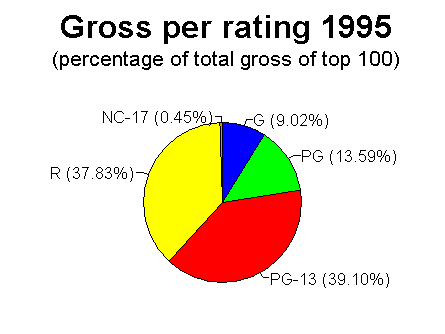
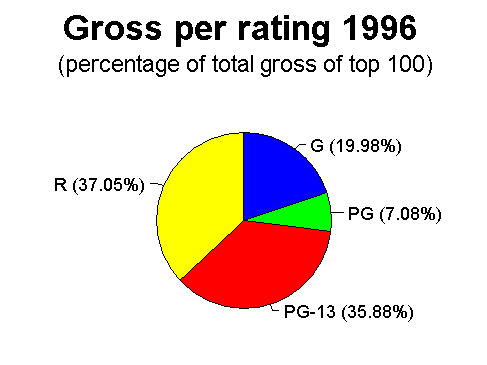
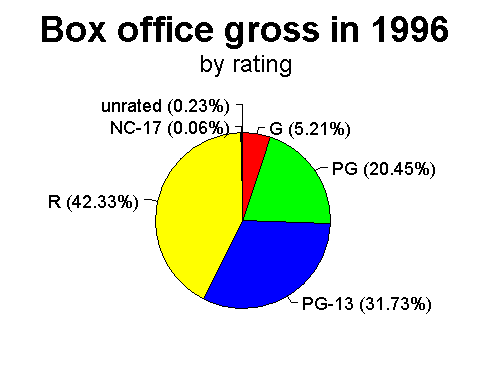
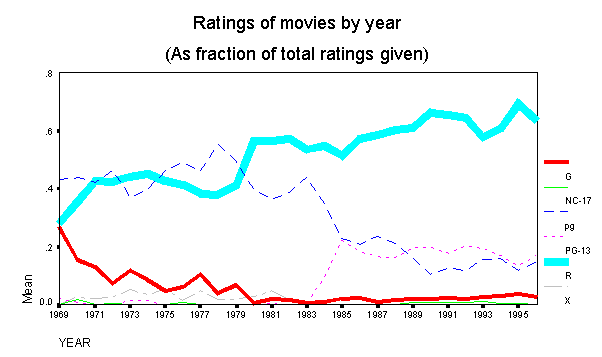
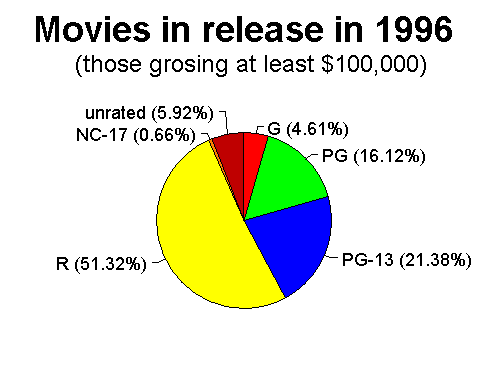
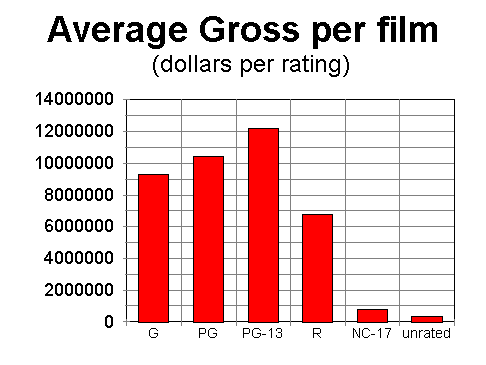
Appendix II: GSS PornoMoral question responses and the number of restricted films produced in the given years.
| year | restricted films | Pornography bad (%) | Pornographybad (n) | Pornographyok (%) | pornographyok (n) |
| 1975 | 45 | 0.513 | 765 | 0.395 | 588 |
| 1976 | 56 | 0.546 | 819 | 0.374 | 560 |
| 1978 | 56 | 0.568 | 873 | 0.379 | 581 |
| 1980 | 103 | 0.6 | 881 | 0.325 | 477 |
| 1983 | 94 | 0.583 | 933 | 0.358 | 573 |
| 1984 | 117 | 0.613 | 903 | 0.329 | 484 |
| 1986 | 149 | 0.619 | 910 | 0.323 | 475 |
| 1987 | 190 | 0.53 | 1073 | 0.337 | 613 |
| 1988 | 207 | 0.618 | 616 | 0.326 | 325 |
| 1989 | 210 | 0.621 | 643 | 0.312 | 323 |
| 1990 | 266 | 0.608 | 547 | 0.319 | 287 |
| 1991 | 236 | 0.596 | 606 | 0.334 | 340 |
| 1993 | 226 | 0.635 | 670 | 0.301 | 318 |
| 1994 | 264 | 0.567 | 582 | 0.36 | 370 |
Bibliography
Austin, Bruce."Movie Ratings and their Effect on Movie Attendance."1981. Eric Document ED208540.
Austin, Bruce, et al."Movie Ratings: 11 Years of Success Ratios."1980. Eric Document ED191102.
Devany, A.et al."Bose-Einstein Dynamics and Adaptive Contracting in the Motion Picture Industry."Economic Journal. 106(439): 1493-1514, 1996 Nov.
Medved, Michael. Hollywood Vs. America. New York: HarperCollins.1992.
Ratnesar, Romesh, "Hollywood Shuffles" The New Republic. May 12, 1997.
Reuters."PolyGram U. S. Movie Unit Forms Distribution Branch". May 2, 1997. http://www.yahoo.com/headlines/
Reuters."Feature: Dueling Projects Lock Studios in Box Office Death Race". May 5, 1997.http://www.yahoo.com/headlines/
Sawhney, M. S., et al."A Parsimonious Model for Box-Office Revenues of Motion Pictures." Marketing Science.15(2):113-131.1996.
Valenti, Jack. "The Voluntary Movie Rating System." http://www.mpaa.org/ratings.html. December 1996.
Wilson, Barbara, et al."Applying Social Science Research to Film Ratings." Journal of Broadcasting and Electronic Media.1990, 34, 4, fall 443-468.
[1]Valenti, Jack. "The Voluntary Movie Rating System." http://www.mpaa.org/ratings.html. December 1996.
[2]The "Hays Office (named after its first administrator, former Postmaster General Will H. Hays) enforced the provisions of a detailed Production Code which placed specific restrictions on obscene language, ex, violence, religious ridicule, ethnic insults, drug abuse, and other potentially offensive elements."(Medved, p. 281) It was in effect from 1930 until 1967.
[3]Medved, Michael. Hollywood Vs. America. New York: HarperCollins.1992.
[4]Valenti, Jack. "The Voluntary Movie Rating System" http://www.mpaa.org/ratings.html. December 1996.
[5]Austin, Bruce, et al."Movie Ratings: 11 Years of Success Ratios." 1980. Eric Document ED191102.
[6]Wilson, Barbara, et al."Applying Social Science Research to Film Ratings." Journal of Broadcasting and Electronic Media.1990, 34, 4, fall 443-468.
[7]Austin, Bruce, et al."Movie Ratings: 11 Years of Success Ratios." 1980. Eric Document ED191102.
[8]Austin, Bruce, et al."Movie Ratings: 11 Years of Success Ratios." 1980. Eric Document ED191102.
[9]From the website http:///www.imdb.com/ The file available is a plain text file detailing all the ratings available from various countries as entered by users of the site. The ratings for the United States are fairly comprehensive, and represent years of moderated collection of data. They were obtained in a plain text format, and were modified using Perl language scripts.
[10]Internet site: http://www.leonardo.net/aasen/
[11]For top 100 films in 1995, Restricted mean: 49681004.8; Unrestricted mean: 39215176.6; F=2.4971; Sig. = .1173.
[12]Wilson, Barbara, et al."Applying Social Science Research to Film Ratings." Journal of Broadcasting and Electronic Media.1990, 34, 4, fall 443-468.
[13]Kilday, Gregg."Risque Business." Entertainment Weekly, January 10, 1997.
[14]Austin, Bruce, et al."Movie Ratings: 11 Years of Success Ratios." 1980. Eric Document ED191102.
[15]Reuters."PolyGram U. S. Movie Unit Forms Distribution Branch". May 2, 1997. http://www.yahoo.com/headlines/
[16]Reuters."Feature: Dueling Projects Lock Studios in Box Office Death Race". May 5, 1997.http://www.yahoo.com/headlines
[17]Restricted: R, NC-17; Unrestricted: G, PG, PG-13; Unrated films are not included.